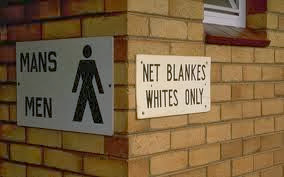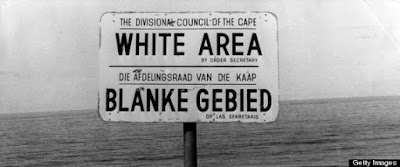Ishekomborera Africa

Reading Glee's blog post about institutions this morning made me think about apartheid.
You may or may not know that I lived in Africa. Post independence, in Zimbabwe - I was such an awful teenager that my mother packed me unceremoniously off to live with my godmother on a cotton farm in Shamva. True story.
I was fourteen years old.

Okay, the picture is hilarious. Let's just get the embarrassment out of the way. Yes, I had a mullet. I had sewn the oh-so-stylish pink dress that I am wearing, and I was on my way to church. It was 1983.
I had absolutely no experience with racial discrimination. I lived in Thornlie, south of the river in WA - a boringly average suburb filled with mostly middle class white people and a few migrants. My best friend in primary school was Malaysian, and the progressive private school I attended was a bit of a melting pot of cultures. So when I landed at Harare airport and looked out the window at a sea of black faces, it was a bit of a culture shock.
My godparents, Joan and Geoff - that's Joan in the picture - ran a cotton farm a few hours out of Harare. They lived in a big mudbrick house on the hill, and had two 'garden boys' and a 'house boy'. Not a large pool of servants, by Zimbabwean farming standards - but for a middle class white girl, the idea of having servants - people who were in your house, doing the work you should be doing - was a little mind boggling. The farm workers and servants lived in rondavels, round, thatched huts down in a 'compound'.
Are you getting the picture? The first day I woke up and looked out the window, my mind went into overload. Women with bare breasts and babies on their backs, colourful skirts and pots on their heads - National Geographic stuff.
That was nothing compared to my first term at school. We weren't particularly wealthy, so I attended a public boarding school, Roosevelt. And that is where my introduction to racial discrimination began.
It took a while. The few white girls at the school readily accepted me as their own, but the black girls were scarily aloof. This was only a few years post independence - four years, so the memory of terrorism and war was fresh in everyone's minds. As was the theme of power and control - the power had been wrested out of the hands of the whites by the masses and things were oh so different.
So imagine this. Samantha, in her maroon and turquoise striped blazer, complete with straw boater - clueless about racial undertones and struggling immensely with O level African geography and the Shona language.
I didn't even know why the white girls wouldn't sing the National Anthem. I didn't know that after independence, in 1980, the Anthem had changed to Ishekomborera Africa - the white girls mouthed the words, a mutinous expression on their faces. One girl was pulled up severely for playing 'Rise O Voices of Rhodesia' (the former anthem) on the piano - she got away with it, because the tune is also 'Ode to Joy'. But I didn't know about the history of the 'struggle', and sang along with great gusto -
Ngaisimudzirwe zita rayo
Inzwai miteuro yedu
Ishe komborera,
Isu, mhuri yayo.
Huya mweya
Huya mweya komborera
(repeat previous two lines)
Huya mweya
Huya mweya woutsvene
Uti komborere
Isu mhuri yayo.
There was racism on both sides. Most of the black girls refused to speak with the white girls - some actively bullied them. I made a very good friend (I miss you, Memory Mutaratigwa) and was consequently 'defriended' by some white girls I knew. It was all very strange.
Later, my mother moved me to a school which was then predominantly white, Arundel School. People were more openly racist there, and the few black girls were from privileged families.

Every time someone made a racist comment, the words fell on my ears with a jarring note. Even when they weren't intended to be racist.
'You'll have to peel the mangoes, Samantha. Notis (the house boy) can't do it - their hands sweat more than ours do.'
'You can't go down to the compound to play with the African children - they are different from us.' (And for hours and hours, we would sit outside our big house on the hill and beat a monkey skin drum, waiting for the drummed response from the children who were so different than we were.)
'Tsatse has cut his knee badly on the lawnmower - we will put him in the back of the ute and take him to the African hospital.' (The hospital, it turned out, was a thatched open air hut in a field. Tsatse almost bled to death on the trip in.)
In history, we learned about the inequalities that existed in South Africa. Apartheid is racial segregation - here are the things I learned.
The Prohibition of Mixed Marriages Act of 1949 prohibited marriage between persons of different races, and the Immorality Act of 1950 made sexual relations with a person of a different race a criminal offence.Under the Reservation of Separate Amenities Act of 1953, municipal grounds could be reserved for a particular race, creating, among other things, separate beaches, buses, hospitals, schools and universities.
The first grand apartheid law was the Population Registration Act of 1950, which formalised racial classification and introduced an identity card for all persons over the age of eighteen, specifying their racial group. Official teams or Boards were established to come to an ultimate conclusion on those people whose race was unclear.
Education was segregated by means of the 1953 Bantu Education Act, which crafted a separate system of education for African students and was designed to prepare black people for lives as a labouring class.
The Bantu Authorities Act of 1951 created separate government structures for black and white citizens and was the first piece of legislation established to support the government's plan of separate development in the Bantustans.
I read Glee's blog and started thinking about apartheid and disability.
Do we have an apartheid system for people with disability in Australia?
Segregated schools - tick, crafting a separate system of education for disabled students and designed to prepare disabled people for lives that will no doubt be significantly different from their non disabled counterparts.
Separate government structures for disabled and non-disabled citizens - tick. We have disability employment services, and people with disability who try to access many mainstream supports are promptly shunted off to the 'special' service down the road. They also experience significant disadvantage under some of those 'special arrangements' - the discriminatory BSWAT test, for example, which means that employees can be paid as little as $1.75 an hour. Or the 'rules' that mean that you can't look for another job until you've quit the current one - our special systems aren't so special after all.
We segregate people by diagnosis and put them into institutions and nursing homes and create segregation and isolation everywhere you look. It makes us even more 'special'. Let's lick the windows on the special yellow school bus, let's sterilise our girls so that they cannot breed, let's lock up people without charge for decades. We even have special toilets.
I knew, when I heard the language of segregation, that racism is wrong. I know that the same is true for people with disability.
It took til 1994 for apartheid to be completely abolished in South Africa, long after the commencement of protests and affirmative action against injustice. I wonder how long it will take our peoples to abolish segregation. A hard fight, because we're not even all on the same side.
It always seems impossible - until it's done.
- Nelson Mandela



Comments
Post a Comment